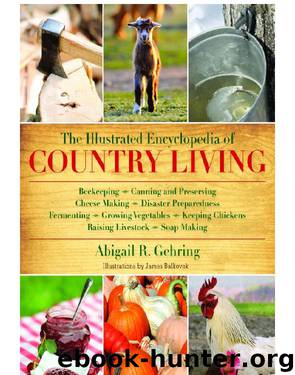The Illustrated Encyclopedia of Country Living by Abigail R. Gehring

Author:Abigail R. Gehring
Format: epub
Publisher: Skyhorse Publishing (Perseus)
Cover the bundle in water and bring it to a boil. Cook it until the water is richly colored, adding water as needed to keep the bundle covered. Remove the bundle. You have now created a concentrated dye.
Pour the concentrated dye into a large pot and add enough cold water to make four gallons. Add whatever material you are going to dye and slowly bring the dyebath to a simmer or boil, depending on what material you are dyeing. Cook it until it is the desired shade of color. Cool the material, either inside or out of the dyebath, and then rinse it thoroughly. Alternatively you can cool your material faster and rinse at the same time by dipping it in successively cooler water baths. Gently squeeze out rinsed material and hang it to dry.
Both animal fibers like wool and silk, and plant fibers such as cotton and linen can be dyed in the same way. How ever, plant fibers do not absorb color as well as animal ones; the times given below are meant for dyeing wool. To dye cotton or linen the material must be boiled from one to two hours in the dyebath.
Types of Dye
Reds—Cochineal, the powder from the crushed cochineal insect, will make rich reds and scarlets. It can be purchased from any dye supplier. Unlike most other plant materials used in dyeing, cochineal can be dissolved directly into the water and does not need to be put into a cheesecloth bundle. It takes about 30 minutes to dissolve completely, after which the water should be boiled for 15 additional minutes to create the dyebath. Simmer any material for ½ hour.
Madder is a root, used since the Middle Ages, to create bright reds and deep oranges. To prepare madder, soak the dried root overnight, then simmer for ½ hour. Any material should first be mordated in alum, and then simmered in the dyebath for ½ hour.
Butterfly weed will produce a lighter reddish-orange. Pick one bushel of blooms and soak them for one hour, then boil them for an additional ½ hour. Simmer material premordated in alum for ½ hour.
Yellows—Many things found in nature can produce yellow dyes.
The flower of the coreopsis will produce a bright yellow. Simmer two bushels of flower heads anywhere from ½ to one hour, until the desired color is reached. Simmer material that has been pre-mordated in alum for ½ hour.
Sophora flower makes a darker yellow. To create the dyebath boil one bushel of flowers for ½ hour. Simmer material pre-mordated in tin and cream of tartar for ½ hour.
Goldenrod, as its name suggests, creates a rich gold-colored dye. Take two pounds of blooming flowers, both the flowers and the stems, and simmer for ½ hour. Add material pre-mordated in alum and simmer for ½ hour more.
The dry, outer layers of onion skins can produce a yellow dye. Take two pounds of the outer skins and simmer them for twenty minutes, making sure not to overcook them. Simmer material that has been pre-mordated in alum for twenty minutes in the dyebath.
Download
This site does not store any files on its server. We only index and link to content provided by other sites. Please contact the content providers to delete copyright contents if any and email us, we'll remove relevant links or contents immediately.
Compact Houses by Gerald Rowan(2072)
Food Storage for Self-Sufficiency and Survival by Angela Paskett(1992)
Backyard Chickens Beyond the Basics by Pam Freeman(1907)
Lagom by Niki Brantmark(1680)
100 Skills You'll Need for the End of the World (as We Know It) by Ana Maria Spagna(1667)
The Unsettlers by Mark Sundeen(1649)
The Magickal Family by Monica Crosson(1640)
Pure Charcuterie: The Craft & Poetry of Curing Meat at Home by Meredith Leigh(1613)
Living Off the Grid by David Black(1599)
Mother Earth News Almanac by Mother Earth News(1503)
The Backyard Homestead Guide to Raising Farm Animals: Choose the Best Breeds for Small-Space Farming, Produce Your Own Grass-Fed Meat, Gather Fresh ... Rabbits, Goats, Sheep, Pigs, Cattle, & Bees by Gail Damerow(1446)
A Life Less Throwaway by Tara Button(1446)
Backyard Foraging by Ellen Zachos(1363)
The Sustainable Asian House by Paul McGillick(1356)
The Backyard Homestead Seasonal Planner by Ann Larkin Hansen(1356)
Fruit Trees, Berries & Nuts by Kim Pezza(1339)
Building Today's Green Home: Practical, Cost-Effective and Eco-Responsible Homebuilding (Popular Woodworking) by Smith Art(1265)
Life Without Plastic by Chantal Plamondon & Jay Sinha(1250)
Making Transparent Soap by Catherine Failor(1237)
